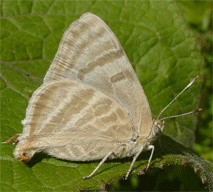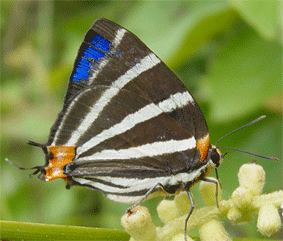

For a spectacular show of butterflies, northern Mexico in September rivals anyplace on earth. Although Amazonian rainforests hold more species, for a combination of tens of thousands of butterflies of hundreds of species, this area is hard to beat. Roughly 600 species of butterflies have been found in the general area we will visit. On last year’s trip we saw about 325 of those. At particular spots near Ciudad Victoria, a greater number of swallowtails and hairstreaks have been seen by experienced tropical butterfliers than at any other location in the Americas! Another plus is that, for the most part, the butterflies of this region will be identifiable to species – species such as Common Banners, Common Morphos, Carousing Jewelmarks, Glaucous Crackers, Florida Purplewings and Karwinski’s Beauty. Cd. Victoria and Cd. Mante are two medium-sized (about 200,000 people each), non-tourist cities, whose people exude a warmth and friendliness that is refreshing. We will be staying in comfortable hotels throughout the trip.
Day 1/Day 2. Tuesday/Wednesday. Participants have the option of beginning the tour on Tuesday evening in McAllen, Texas, driving to Monterrey, Mexico on Wednesday, or beginning the tour on Wednesday evening in Monterrey, Mexico at the airport.
Day 3. Thursday. We will participate in the NABA 16th of September Butterfly Count held on a spectacular, private 10,000 acre ranch in the Sierra de Picachos. Just 45 air miles from the Texas border, this pristine natural area climbs from tropical thorn scrub into oak woodland into pine-oak forest. I have seen 170 species at this ranch in just four days of butterflying. Depending upon the vagaries of the season, we may see huge swarms of mudpuddling sulphurs and swallowtails, including Ornythion, Three-tailed, and Palamedes Swallowtails. The butterfly garden at the main house is often alive with butterflies. Mexican Tiger Swallowtails, Creamy Stripe-streaks, Rosita Patches, dazzling Teal Beamers (Phocides urania), and black and iridescent blue Gilbert’s Flashers are just a few of the species we have seen here. Night in Monterrey.
Day 4. Friday. This morning and early afternoon we will butterfly La Estanzuela Park, on the south side of Monterrey. With wide, flat pathways bordering a stream that winds through lush tropical forest, this is one of the easiest areas in which to find tropical species such as Three-tailed Swallowtail and the aptly named Magnificent Swallowtail. Common Greeneyed-Whites (Leptophobia aripa), a Florida White look-alike but with brilliant green eyes, Chestnut Crescents, Common Banners and endemic East-Mexican White-Skippers (Heliopetes sublinea) are also here. More than 100 species have been seen at this park in one, two hour time period. In the late afternoon we will drive to Ciudad Victoria, Tamaulipas. Night in Cd. Victoria.
Day 5. Saturday. In the vicinity of Cd. Victoria, a canyon snakes along a riverbed for about 8 miles, gradually climbing higher up the mountainsides. Almost 20 species of swallowtails have been found in this canyon! Dark Kite-Swallowtails and Red-sided Swallowtails (Mimoides phaon) may be abundant. If conditions are right, as they have been in the past, we may see hundreds of swallowtails in quivering mudpuddle masses. Occasional blooms of hairstreaks and skippers may throng flowering trees. This is one of the best spots to study the amazing Superb Cycadian (Eumaeus childrenae). A close relative of the Florida Atala, this hairstreak is the most un-hairstreak-like hairstreak you’ll ever see. First, it is huge – roughly the size of a Viceroy. Second, it has a rapid sailing flight, something like that of a Monarch (but with the wings not held in a V), quite different from the usual nervously swirling flight of hairstreaks. The upperside looks like black velvet with brilliant iridescent green highlights and a wide iridescent turquoise band along the HW border. Below, the wings of this Mexican endemic have more than 100 brilliant iridescent dots, gold on the female, turquoise on the male.
Day 6. Sunday. About 1 ½ hours south of Cd. Victoria is the northernmost tropical rain forest in the Americas – El Cielo Biosphere Reserve. Truly tropical species abound. More than 300 species have been found at this site. We have excellent chances of seeing crackers, large and swift preponas, Whitened Bluewings (Myscelia cyaniris), daggerwings, and beauties. The list of hairstreaks and metalmarks present is quite satisfying and includes the very large and spectacular, iridescent green Regal Greatstreak (Evenus regalis) and the brilliant Black-patched Bluemark (Lasaia agesilas). Celadon Sisters (Adelpha serpa celerio), with a faint greenish cast to their white bands, and Orange Banners (Temenis laothoe) may be spotted. Two species of iridescent blue leafwings and giant-satyrs may be flying in the undergrowth. Of the many skippers, Red-collared Firetip (Elbella scylla) and Death-mask Spurwing (Antigonus nearchus) particularly stood out. A truly wondrous area. In the late afternoon we will drive to Mante. Night in Cd. Mante.
Day 7. Monday, and Day 8. Tuesday. We will spend these two days southwest of Mante in the mountain forests of northern San Luis Potosi. This lush area abounds with butterflies. Montezuma Cattlehearts (Parides montezuma), Ghost Yellows and Common Morphos (Morpho peleides) may be common. A range of fascinating metalmarks may leave their mark on us – the incredible Sword-tailed Beautymark (Rhetus arcius), the lovely yellow and bejeweled Polka-dot Yellowmark (Baeotis sulphurea), and the fascinating little Snappy Mottlemark (Calydna sturnula). Clearwings blend into the background, until one looks at, not through them, while Zebra Cross-streaks (Panthiades bathildis) are dramatic no matter what one’s view. In the dim light of the forest understory we will seek elusive white-satyrs and blue-satyrs.
Day 9. Wednesday. This morning we will drive north, revisiting the El Cielo area. If past experience is any guide, we should add a long list of species not seen on our previous visit. Night in Cd. Victoria.
Day 10. Thursday. Depending upon condition, we may drive about 20 minutes south of Victoria into oak-covered hillsides at about 4500 ft. to visit a different habitat. This area has a very different mix of butterflies than our other stops and has been particularly productive for hairstreaks in past years. The very rare Lilaceous Hairstreak (Apuecla maeonis) has been found here, along with at least three species of greenstreaks and Mexican Cycadians. Alternatively, we may drive north to Horsetail Falls, a lushly forested area south of Monterrey. In the afternoon we will drive back to Monterrey.
Day 11. Friday. The trip ends this morning at the Monterrey airport, or for those who began the trip in McAllen, later in the day at the McAllen airport.
Leader will be Jim Brock, co-author of Houghton Mifflin’s Butterflies of North America.
Cost of the trip is $2695/person from Monterrey; $2845 from McAllen. Cost includes double-based accommodations, meals, ground transportation, airport transfers, tour leader fees and entrance fees. Not included are alcoholic beverages, laundry services, and other items of a personal nature. Single supplement is $350. This trip is limited to 8 participants.
Click Reservations for a Reservation Form.

A Teal Beamer
at La Estanzuela





Sunstreak Tours home page Tour Calendar Tours by Region
Northeastern, Mexico
Wednesday August 29, 2007 to Friday September 8, 2007